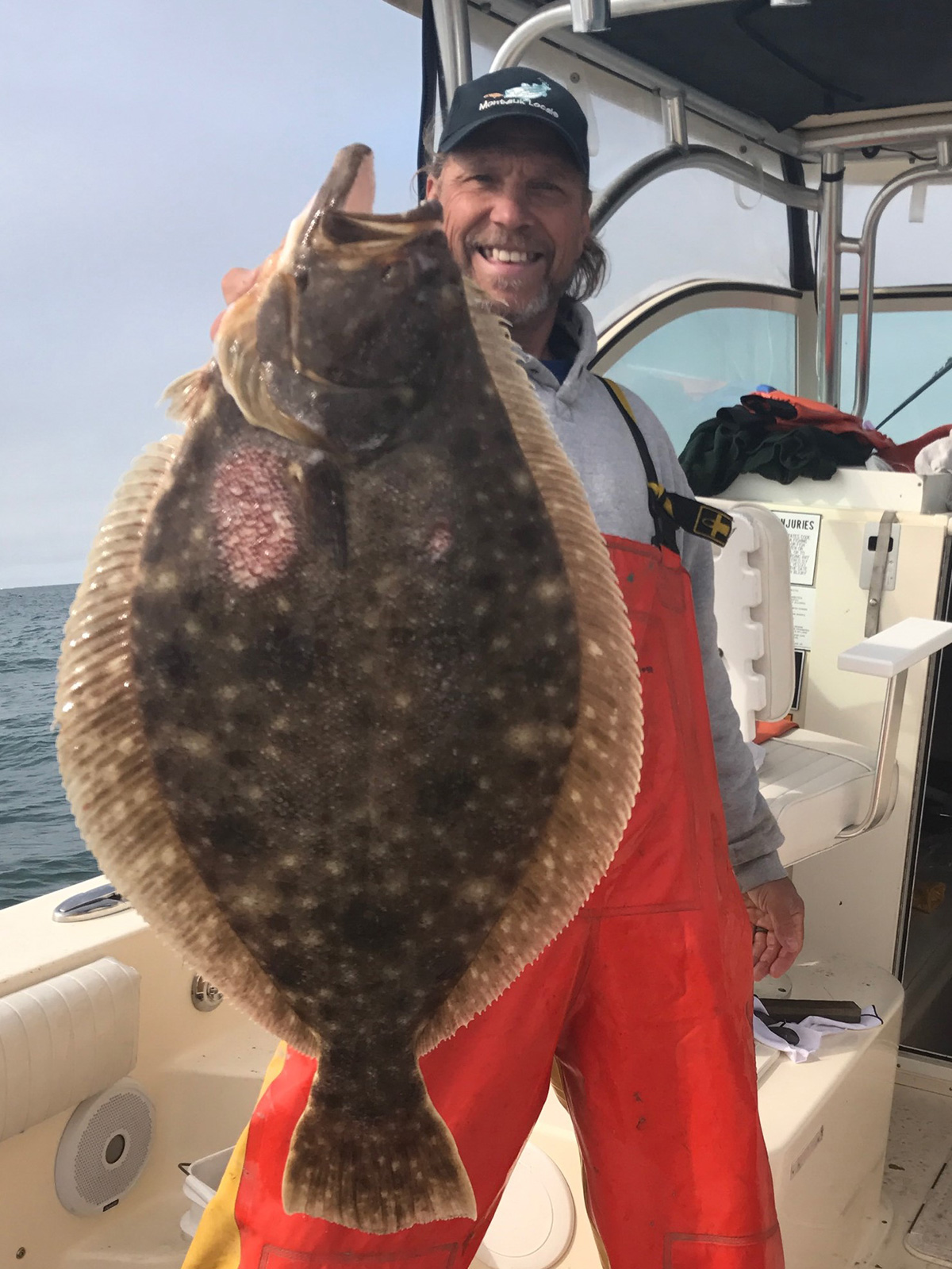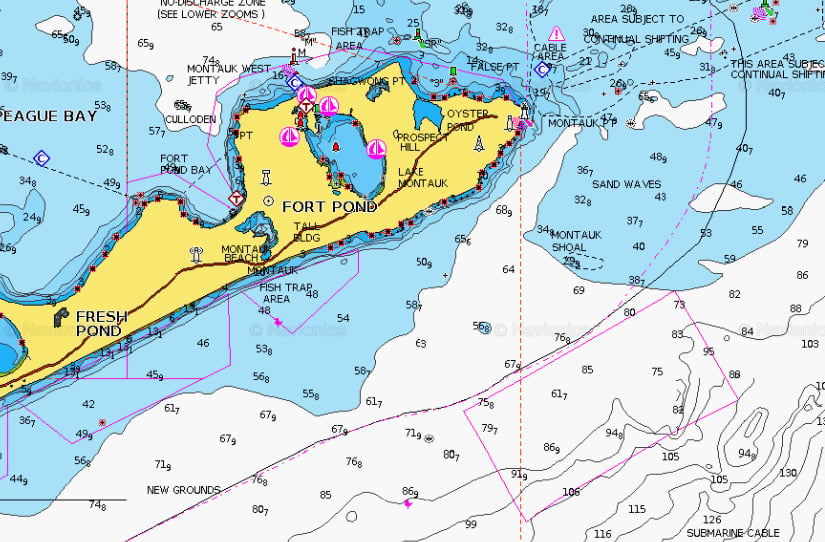
In the 1970s, open boats such as the Lazy Bones, Marlin, Viking and many other open and charter boats would line their top rails with “hangers” consisting of doormat fluke caught that day. Those days occurred quite often during the fall, particularly in September. Fast forward to the present day where technology and the simplicity and affordability of sonar and navigational electronics have become a huge asset in locating big fluke during the summer months in the structure-rich waters south of Montauk Point. One such area, known as the Frisbee Grounds, is only a 5-mile hike southwest of the Montauk Point lighthouse, where some great action with monster fluke and jumbo sea bass await during August.
Shaped Like a Frisbee
Frisbees (N41.00.86/W71.52.34) is an area of rocky terrain with water depths ranging from 60 to75 feet. The name is derived from an area that rises to 55 feet in the center of this structure. Both the inner and outer Frisbees are basically a magnet for big fluke and some real knucklehead sea bass during the summer months. The best spots to fish on Frisbees are dotted with lobster trap markers from east to west on most of the rocky perimeter. Fluke activity begins here by early July and continues right through the season’s finale at the end of September. During the summer months the area is hard pressed by monster fluke hunters, which can pick the more popular areas clean in spite of their size.
If the picking seems slow due to heavy pressure, fret not as you can move a little further south and work the rocky lairs of the Cartwright Grounds where once again perseverance can pay off big time. I would strongly suggest instead of leaving the area, make long and consistent drifts over the high rocky pieces, but stay clear of the lobster pots. Drifting the rocky sections will almost certainly cost the loss of some rigs, but the payback in double-digit fluke eases the pain quite quickly. If you plan on employing this method, use plain Jane rigs and the lightest sinkers possible to hold bottom. Save those expensive bucktails, chrome balls and all those other costly gizmos for when you drift along the sandy fringes of the grounds.
Not So Fast
Since we are on the subject of drifting, generally speaking, a drift of 1 to 1-1/2 knots is ideal since this speed keeps the fluke aggressively chasing down your offerings while minimizing the activities of undesirables such as skates and crabs. A drift slower than a half knot often results in a burdensome pick of skates, which can make for a frustrating time. Unfortunately when it comes to drift speed and drift patterns, we are at the mercy of Mother Nature where wind and the speed of the current are beyond our control. Fortunately on days when Mama isn’t so cooperative, we do have a few moves that keep us on the meat. When the drift is nonexistent, kicking the engine in and out of gear and keeping the boat at a knot to a knot and a half helps ease the skate activity and definitely draws the interest of fluke. On the other hand when the drift is much over 2 knots, it may be too fast for the depth of water at Frisbees and requires heavy weights to hold bottom, resulting in numerous short strikes, particularly in the deeper water of Frisbees.
All is not lost however, as a sea anchor provides the solution to slowing the speed of the drift and allowing the rig to remain on the bottom, giving fluke a chance to attack the offering. This holds especially true for the larger fluke since they tend to be lazier and normally don’t bother with a fast moving bait.
Note the Surroundings
Fluke fishing around structure in areas such as the Frisbee Ground is in a category all to itself, and to understand the layout of the bottom structure is truly beneficial. While navigation charts and electronic devices certainly assist in getting to the charted area, they won’t tell you how they are structured. Therefore, some brain salad, trial and tribulation goes a long way in putting a few slabs in the box. Basic 101 just won’t cut it here. Drifting directly over a high piece of big boulders or stones often results in hang ups and lost terminal tackle. Hence drifting along the sandy fringes located in the nooks and crannies between the big boulders and large rock piles are where 75 percent of the fluke are looking to ambush their next meal. While being close to a piece of structure is a good idea, it is not always paramount. I find that fluke tend to wander within a quarter-mile radius of the structure at times, especially when there are baitfish swimming close by and using the structure rich bottom as refuge from predator species on the prowl for an easy meal. Then again, if the loss of terminal gear is not relevant, you can bet your last dollar that teen-size fluke swim over the clusters of rocks and stones chasing down juvenile porgies and crunching down tasty Jonah crabs, both of which are high on an ocean fluke’s menu.

Gearing Up
When fishing Frisbees or any area with sticky bottom for that matter, your best results come from rods with fast taper tips for sensitivity, and powerful butt tapers for the lift needed to haul any outsize flattie from the bottom. A favorite combo of mine that suits the situation well is a 7-foot KastKing PE-C701MF baitcaster rod joined with an Ecooda Tiro Caster EX reel loaded up with 30-pound braid. The outfit is light yet powerful enough to handle most bottom fishing situations.
Fluke rigs can be as complex or as simple as you wish to make them. You can’t go wrong with the standard Plain Jane rig. As for those with lots of bells and whistles, some of them do a fine job scaring jumbo fluke, while others do a great job of nailing shorts or keepers on the small side. While the rig I favor is no secret and is known as a Christmas Tree Rig, it is extremely effective time and time again under normal drifting conditions during the entire fluke season. First I tie an 8-foot leader of 40-pound fluorocarbon via an Albright knot to the braid. Next on the other end of the leader I slip a 3/8-ounce Spro glow bucktail or Spro glow squid tail approximately 2 feet up the leader and work it inside of a dropper loop. I repeat the process with another 3/8-ounce Spro jig approximately a foot below the top jig. At the end of the leader I use either a 3- or 4-ounce Spro bucktail or a Tsunami ball jig depending on the speed of the drift and water depth. If conditions permit you can go as light on the bottom jig as is required to stay down along the bottom. If it takes more than 6 ounces to bounce along the bottom, then slowing the drift with a sea anchor is a good option.
Contrary to popular belief, you do not need long strips and big baits to slam big fluke. Please don’t be misled, the big baits work very well, just not on the Christmas tree rig. Four-inch strips of squid, fluke belly or better yet, freshly stripped down sea robin belly work great on the small bucktails, while a 7- or 8-inch strip of fresh sea robin belly is hard to beat on the bottom jig. If available, you can add fresh bluefish strips to the menu as well. Standard spearing and sand eels are fine; however, if at all possible, use the freshest strip baits available as these fish much prefer fresh meat.
Know Before You Go
The proper tides are imperative for good results at Frisbees, especially where big fluke are concerned. The first hour and last hour of either of the tides are the best when drifting fluke at the Frisbees. During those stages of the tide the current is at an ideal speed of under 2 knots. The only obstacle, which can also be beneficial, is the speed and direction of the wind. During July and August, an ordinary day sees a southwest wind between 10 and 15 knots after 11 a.m., which can be ideal on an incoming tide. When possible, you may want to plan your trips on days the wind and tides coincide. Winds directly out of the west are often stiff and break up the humidity, as do winds out of the north. Fishing is often good on a west wind, but iffy when out of the north or east. My advice, providing there are no sudden low pressure systems in the forecast, is to just go fishing and make sure you don’t leave the dock with a big enough net to handle Frisbees’ monster doormats.
Most inshore anglers dream of catching that fluke of a lifetime. Although there are a number of areas anglers can travel to and test their skill at landing that monster, quite candidly, the Frisbee Grounds can make that dream a reality. And who knows, you may even nail a contender for the 23-foot Steiger up for grabs in this year’s Fisherman Dream Boat Challenge.



